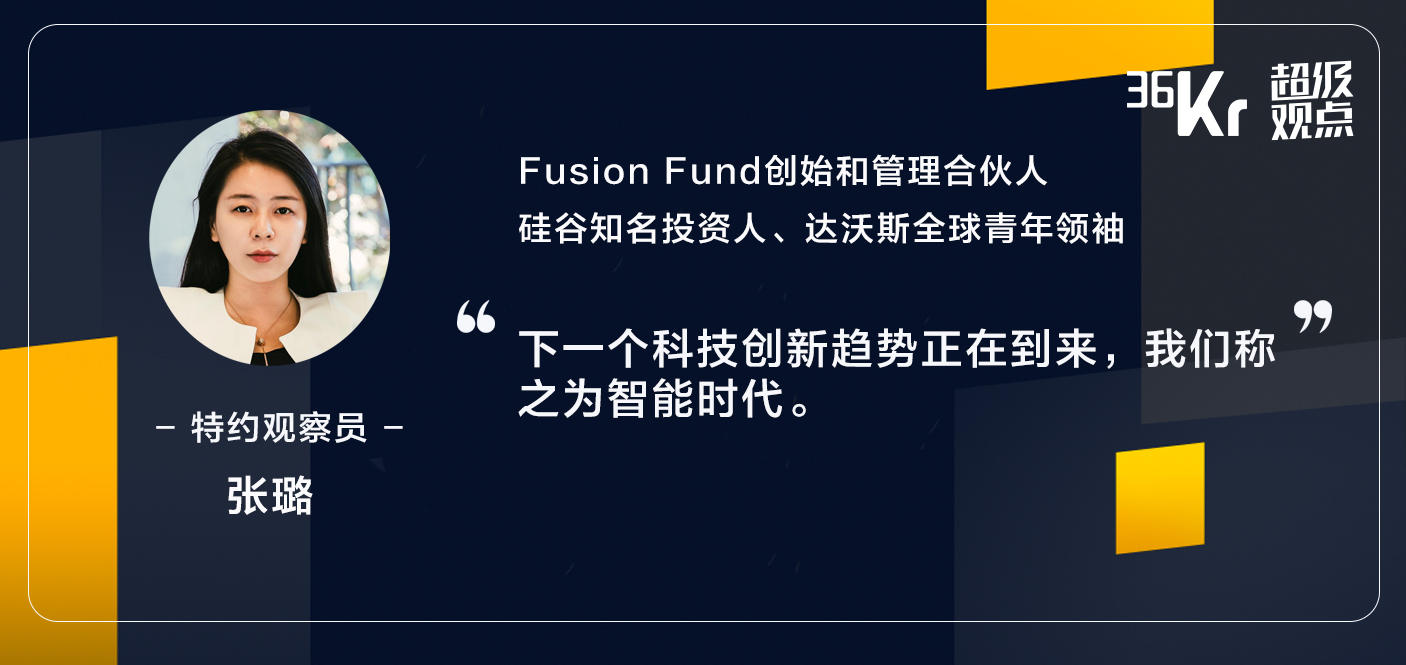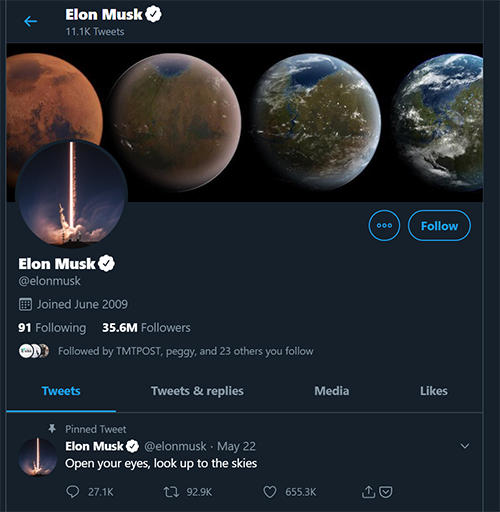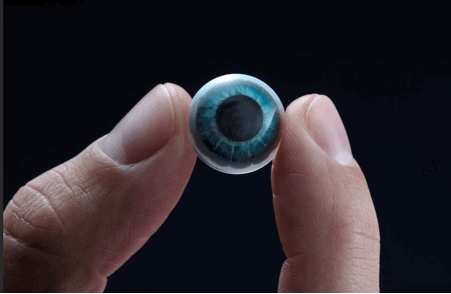The next technological innovation trend is coming, and we call it the intelligent age.
Look at business with perspective. Super point of view, from the frontier observation of new business practitioners.
dictation | Special Observer Zhang Lu Founding and managing partner of Fusion Fund, well-known investor in Silicon Valley
Edit | Huang Zhenyao
Special Observer Zhang Lu
On the afternoon of May 30th, EST, SpaceX’s manned dragon spacecraft successfully launched from Falcon 9 rocket (Falcon 9) from the Kennedy Space Center in Florida. For the first time in the world, a private space company realized a manned space flight.
At the same time, on the evening of the past Wednesday (June 3), SpaceX launched a new batch of 60 satellites and successfully completed the deployment, further advancing the Starlink program (Starlink). So far, SpaceX has deployed 482 Starlink satellites in orbit. This year, it plans to launch every two weeks, starting the first phase of the 12,000 satellites approved for launch, completing the layout of nearly 1,500 satellites, and officially promoting the space Internet The project is expected to complete coverage of North America by the end of this year.
The successful launch of SpaceX marked the beginning of a new era in the history of human spaceflight. This historical moment can be supported and witnessed through capital, and it is also the happiest and most exciting place for me as a Silicon Valley technology investor. Through technology investment, “to change the world while creating wealth, but the most important thing is to change the world.”
Technology innovation companies will lead more aerospace fields
Elon Musk is not necessarily a qualified listed company CEO, but he is definitely a true dreamer and has a very strong execution. From electric vehicles, to commercial aerospace, to the future of Starchain, he can always challenge the tradition with his own efforts, promote technological innovation in the entire field, chase human dreams, and inspire everyone to “Open your eyes, look up to the skies”.
Elon Musk’s top Twitter
After this successful launch, SpaceX broke the situation in the aviation field where national power is dominant, opened the road to the future commercialization of space navigation, and let everyone see the technological innovation, operational efficiency and cost control of private commercial companies. Huge advantages.
When NASA first did space exploration, there was an internal rule: Failure is not acceptable. However, for commercial companies, the exploration of technological innovation often requires continuous trial and error. After going through the entire innovation cycle, the correct path can eventually be explored, and the company’s overall planning ability and risk control are crucial.
In addition, business companies pay more attention to cost and sustainable business models. This means that in addition to the successful launch, SpaceX also needs to carry out more technological innovations to focus on cost control, including various recycling technologies, so as to better reduce technical costs, launch costs, and form a more advantageous strategic technology choice . These are all natural characteristics of commercial companies.
In addition to rocket launches and manned spaceships, there will be more spaceflights in the future to be led by technological innovation companies. At present, there are more than 430 space-related startups in the market that have received more than $20 billion in financing, ranging from satellite-powered Internet of Things networks to planetary mining.
And for China’s aerospace industry, there are many opportunities. SpaceX gives a very good example of how private companies can cooperate with the government to complement each other’s strengths and develop faster technologies. The trend of China’s commercial aerospace industry has just started, with great potential. At the same time, there is no mature enterprise like SpaceX, so there is still a lot of room for development.
Humanity is entering the era of intelligence driven by emerging technologies
The aerospace industry in the United States has only been open to private enterprises for more than 10 years. Private institutions such as SpaceX, private institutions, and private companies have been able to set foot in this industry. It is also because the development of new technologies has lowered the entry threshold for aerospace technology. Let an industry that is heavy in assets, large in investment, and high in trial and error costs begin to change quietly.
One of the important new technologies is 3D metalprint. Through metal printing, the integration of components can be formed. This feature is particularly important for aerospace science and technology, because no matter how sophisticated instruments are put together, there will always be problems on the calibration level that are not visible to the naked eye. This small calibration problem can be infinitely magnified in the extreme environment of outer space during the launch process, causing danger.
The 3D metal printing technology can now basically eliminate impurities and bubbles in the printing process, adapt to different new materials, and the printing speed is also rapidly improved, solving the problem of calibration and material defects.
For example, if you want to make a rocket turbine, three parts may have been assembled together, but now through 3D metal printing, we can print the three parts into one. After one-piece printing, they are a complete metal part, and the possibility of failure is greatly reduced. At the same time, the printing process can be well controlled to remove bubbles and impurities in the material, and the final part strength will be better.
On the other hand, with the maturity of technology and the improvement of efficiency in the past few years, the cost of 3D metal printing is also reduced, and it is more flexible compared with the mold opening process of traditional industrial production. In addition to aerospace technology, 3D metal printing technology is also rapidly applied in many other fields, including medical and high-end manufacturing.
And 2020 is also a special node of technological innovation. Many cutting-edge technologies with a strong sense of science fiction have entered the stage of commercialization, from basic technological innovation to the stage of technological application innovation.
Before I often mentioned, Technological innovation occurs in the form of a cycle, and at the beginning it is basic technological innovation; followed by technological application innovation, implanting technology into various application scenarios and In the industry; Finally, the application of technology will inevitably lead to business model innovation, which will bring the original industry leader to the altar through efficiency improvement.
In the past ten years, we have experienced an Internet-based technological innovation wave, from the earliest Internet basic innovation to application innovation, which is a complete innovation cycle.
However, the innovation of business models based on the Internet can be said to have passed the blowout period, and the next trend of technological innovation is coming. We call it the intelligent era-an intelligent era driven by various emerging technologies .
In addition to aerospace technology, the intelligent era also includes various applications based on software and hardware integration, data and AI as tools, including human-machine interconnection, flexible circuit/software robots, and edge computing-driven network technology upgrades. A new generation of information carrier technology, bioinformatics and other emerging technologies.
Nano-robot technology is one of the key technologies to realize human-machine interconnection, integrate our human brain and machine brain, and even form a super-brain in the future. Silicon Valley enterprise P invested by the US Department of DefenseAradromics has developed a nanorobot driven by nanofibers.
When the nanorobot is implanted in the brain, it can reconstruct the transmission of neurotransmitters, repair brain function, and treat brain damage. For brain diseases such as Parkinson, whether it is treated with drugs or stimulated with neurons, it is difficult for brain neurotransmitters to reconstruct its transmission, but the nanorobots made by Paradromics are like the concept of heart bypass. Nanofibers are used to reconstruct the transmission of brain neurotransmitters to partially repair brain damage. Even if it is applied to normal people in the future, it will not only allow us to connect with machines, but also help humans further strengthen brain functions. Before we move towards the human superbrain, nano-robots can already have good applications in this field.
Another example is flexible electronics, whether it is for existing electronic products or the way we interact with the world in the future, it will bring huge changes-in our previous generation of technological innovation, we used fingertips As a medium for exchanging information with the world, touch the screen, sense the world, and then obtain information. However, if flexible circuits and artificial skin are pushed out on a large scale, all parts of our bodies can become an interface for interacting with the world, and at the same time, we can obtain further extensions. A further change is a change in the shape of the human external skeleton. From hardware to body-fitting materials, such as the evolution of Iron Man’s mechanical armor in Avengers. In the future, there may be applications for software robots to complete heart surgery, or to replace human hands to pick fragile fruits and vegetables such as strawberries and blueberries. These are some new application scenarios brought by artificial skin software robots.
The above mentioned some very exciting technologies, they actually all have a core.
is a connection.
The desire for a better connection highlights a huge demand today-we need a better way and technology to achieve the connection, we need to transfer a lot of information to the cloud, and then feedback. We need faster and more reliable network transmission and connection technology that is infinitely close to zero delay. In the past two years, such network technologies have begun to appear, namely 5G and edge computing.
The core advantage of 5G is increased bandwidth. The amount of data generated every day in the world is growing exponentially compared to the past, and the networks of the past cannot be carried. In the past two years, IoT devices have increasingly entered ordinary homes, industrial interconnections, smart cities, intelligent transportation, etc. We are producing massive amounts of data, so we will inevitably need a larger bandwidth to transmit these data.
But it is still not enough to increase the bandwidth of data transmission, there is still a problem-delay. For example, in the process of unmanned driving, if there is a two-second delay, it is a car accident, so solving the delay is also a very critical technology node, and edge computing solves this problem. Edge computing is goodThe point is that it puts computing and data processing on the edge, which consumes less energy.
AlliedMarketResearch’s research report shows that the edge computing market is expected to exceed US$16.5 billion by 2025. The predictions of many different reports have shown that the industry’s growth rate is extremely high, and it will continue to grow at a compound annual growth rate of at least 30% in the next five to seven years.
Edge computing also brings us a new expectation, that is, the next-generation information carrier technology.
This generation of mainstream information carrier is a smart phone, which is a small computer with all the information on it. Although it is already small enough, people hope that the next generation of devices can be smaller. If you want to achieve this desire, the scale is smaller, the energy consumption is less, and the ability to process information is not bad, then you need a new generation of information carrier.
As you can imagine, when you communicate with others in the future, the medium you pass is a contact lens. When you speak, you can see a variety of information. You can interact with gestures, skins, and voice control. Your interaction with the world will become more seamless, smoother, and more subtle. These are all edge computing, including new opportunities brought by the next generation of network technology-distributed networks.
A company I invested in, Mojo Vision, is committed to achieving this future. They are the world’s first “invisible computing” technology company. By integrating various chips and batteries into smart contact lenses, they can realize the next generation of information carrier technology that may replace mobile phones in the future. When the user wears this contact lens, the display mode of the picture that can be projected in front of the eye through the glasses allows the user to obtain information intuitively and interconnect with the network.
Now their first commercial products have been delivered. Compared to the early ambiguity of Google Glass in product application areas, when they founded earlier, they clearly identified the potential landing direction of some industrial applications, faster Enter commercialization. Mojo Vision has received more than US$150 million in financing.
Mojo Vision product photos
Mojo Vision product photos
Use technological innovation to get out of the economic downturn
Since last year, many of my investors and friends have a hunch that the economic cycle will begin to enter a low tide, but no one knows when. This epidemic is like a tipping point, letting it happen during this period of time, amplifying and presenting the industrial problems that everyone had overlooked and failed to notice. For example, efficiency problems, global supply chain problems, medical system problems.
If you compare the present and 2008, the overall performance of the economy may be worse than in 2008. Because 2008 was a financial market issue that adversely affected physical companies, but now it is traditional enterprises such as transportation, aviation, petrochemicals, etc. that are inefficient themselves, and then suffered huge blows due to emergencies, which damaged business fundamentals. No matter how much capital is invested in the secondary market at this time, how long can it support?
Everyone has their own analysis, and no one can give a definite answer. But one thing is certain, that this economic cycle is bound to come.
Although it sounds pessimistic, if we look closely, When the economic cycle low period occurs, whenever government policy and financial structure adjustments have no way to fundamentally push us out of the economic low period immediately, only Technological innovation can quickly improve efficiency and help us through the low tide.
From the overall economic level, the problems of low efficiency in traditional industries have accumulated to a point of change in the past few years. Traditional petrochemical and insurance banks have become very motivated to integrate new technologies.
The epidemic has magnified the problem to some extent, and it has also pushed many companies to integrate new technologies more urgently and accelerate their digital transformation. For example, the medical field is one of the most conservative and traditional industries. They experienced huge efficiency problems during the epidemic and urgently demanded the integration with new technologies. There are many traditional industries, even luxury brands like Prada and Cartier, which are also undergoing digital transformation.
On the other hand, startup companies will usher in new opportunities in this process. We have seen the power of technological innovation.
For example, an artificial intelligence application company I invested in has received a lot of orders from traditional pharmaceutical companies in the past month. There are also technology companies that focus on the digital transformation of enterprises, with revenues in the past quarter exceeding the full year of 2019.
Most of the companies I invest in are focused onUsed for enterprise and industrial efficiency improvement and digital transformation, such as Huma.ai, to accelerate the application in the epidemic: through the AI engine including natural language processing, deep learning technology, it can help pharmaceutical companies accelerate drug development, in line with safety, remote Deployment requirements; there is also the cloud computing development platform Paperspace, which allows enterprises to efficiently complete machine learning and cloud computing development in the cloud. So in this context, for such a company, the past few months have been a period of rapid growth, and there are still new recruitment needs.
We can see that many emerging technologies are developing and applying rapidly in Silicon Valley. In some traditional industries in the Midwest, the application of basic sensors and data collection technologies is not very high, and there are many opportunities in the future.
The first step in an enterprise’s digital transformation will be driven by AI: including natural language processing, computer vision, and deep learning technologies.
The next step in digital transformation is seen in the industrial sector. We often talk about traditional industries, such as petroleum, chemical, fine chemical, aviation, automobile, transportation and other industries. These industries are characterized by many large offline factories that are constantly generating data, but data collection has always been a large problem.
In the past few years, the popularity of a large number of low-cost sensors has made factory transformation easier. Now you can use the old machine tool to add a small low-cost sensor on it, connect the sensor to the cloud or connect to the intranet to collect information, so as to carry out intelligent monitoring, factory management, and timely pre-judgment. When there is a problem in the machine production line, intelligent information feedback and auxiliary maintenance are performed.
Many industries purchase low-cost sensors for supply chain management and intelligent management of material quantity, as well as predicting accidents. Then analyze these software solutions to realize the central brain of the industry. And these brains can be centrally deployed, making the factory safer, more efficient, and reducing costs, while allowing the project to be upgraded on a large scale.
In addition to these, edge computing is also a very important technology in industrial applications. Through the application of edge computing on intelligent devices, faster information can be returned and the efficiency can be improved.
On the other hand, there is still a very important problem with large American companies, which is the waste of talent. Many companies have many very high-quality talents, but they cannot maximize the talents’ ability, which results in redundant talents and waste of technology. This involves the new opportunity we see, future of work.
Future work styles, regardless of work style, information sharing method, or internal personal ability contribution method, can be better realized and improved through technology. This flexibility is also one of the huge flaws of traditional industries and technology companies. And technology is helping to fill this gap.
Actually, everyGreat companies will be born during the low tide of the secondary market, and we are now in a stage of rapid technological development and rapid commercial application. Maybe we can make better use of this tool and let us survive the low tide period faster— — Promote the digital transformation of traditional industries to improve efficiency, to further fundamentally change productivity, adjust production relations, and change production structure to cope with the current global economic crisis.
The “Super Views” column now launches the “Special Observers to Settle in” program, inviting entrepreneurs from various tracks, business leaders of large companies and other front-line business practitioners to share your entrepreneurial insights, dry goods, and methodology here. Your industry insight, trend judgment, and look forward to hearing your voice from the forefront.
Welcome to contact us, WeChat: cuiyandong66; Email: guanchayuan@36kr.com



